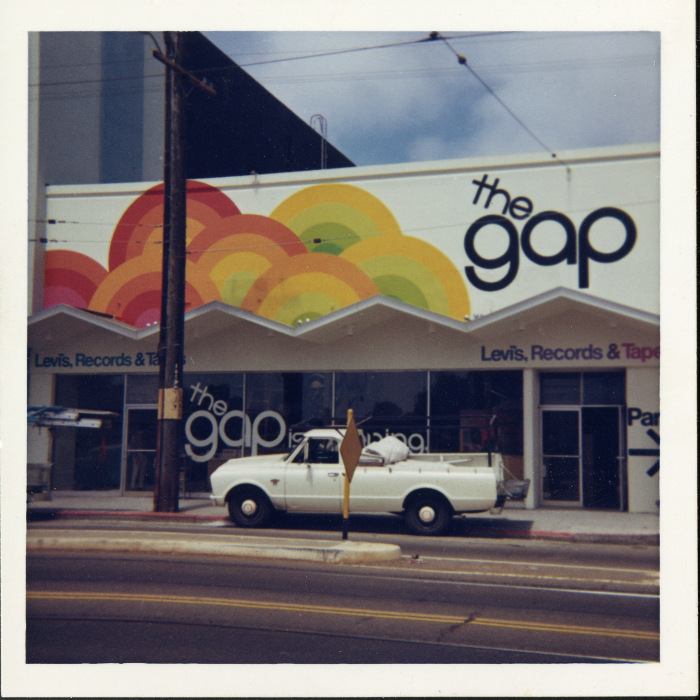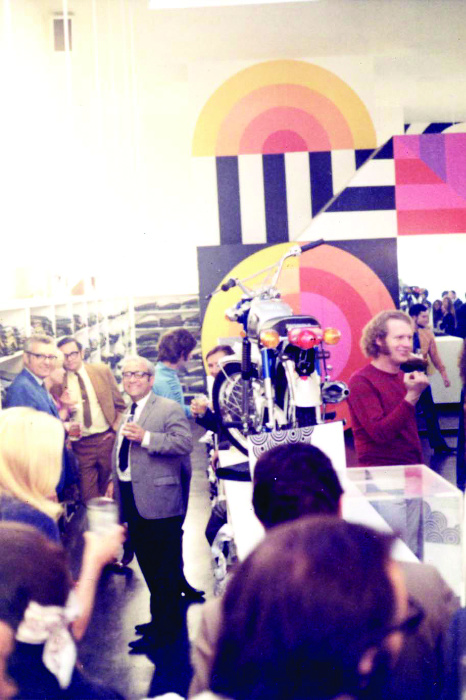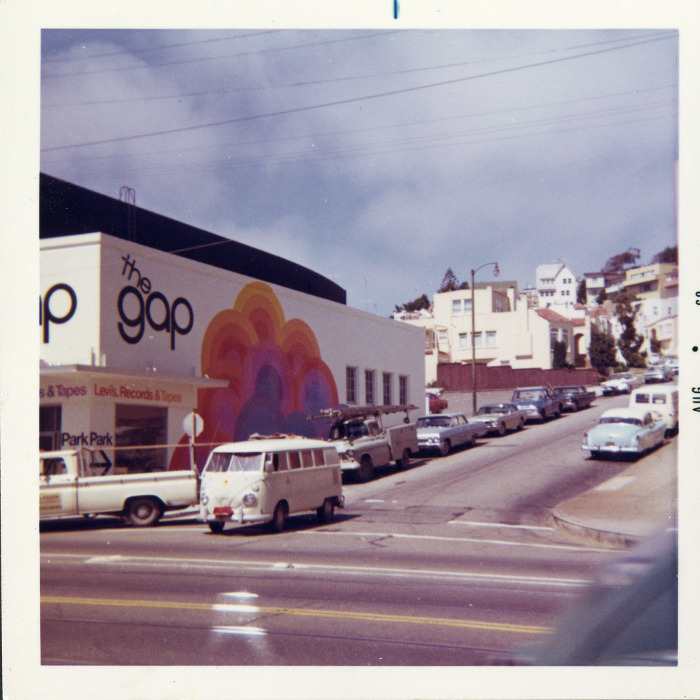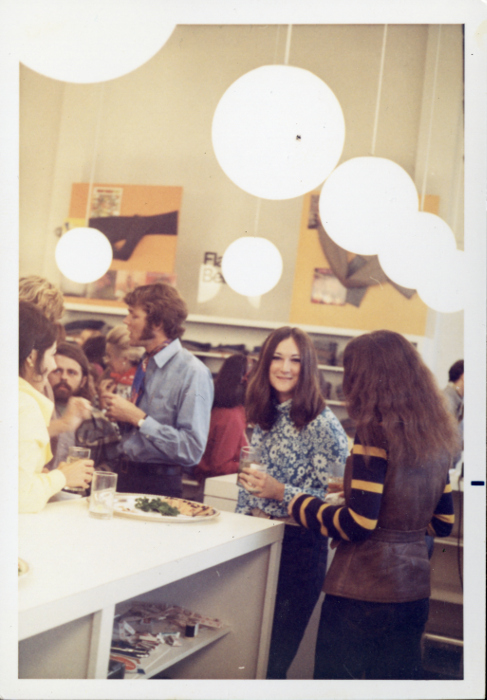Rebecca Arnold, fashion historian and lecturer at the Courtauld Institute of Art, traces Gap’s heritage back to 1960s America – a time and place defined by social unrest, liberal politics and the birth of pop culture


Rebecca Arnold: If 1950s California had been viewed either as a realm of glamour, dominated by images of Hollywood, or a land of suburban conformity, then by the mid-60s such contradictions were completely reimagined: it was no longer a contrast between luxury and white picket fences, but one characterised by a state driven by ideas that encompassed peace and love as well as rebellion and conflict. As Time magazine described it, in its 7 November 1969 edition: “California is virtually a nation unto itself, but it holds a strange hope, a sense of excitement –and some terror – for Americans.” This notion of California as a synecdoche for the United States as a whole was underlined by the title of one of the articles inside: ‘Laboratory in the Sun: the Past as Future.’
Encapsulated within this heading was California as an experiment, its mythic history – a land of promise and plenty, populated by pioneers seeking a new life, and the potential clash or accommodation of this otherness (with New York and the East Coast as the flip side), within the movements for change that emerged during the decade.
As Time outlined, California was “the mirror of America as it will become, or at least as the hothouse for its most rousing fads, fashions, trends and ideas.” Journalists flocked to the state, eager to catalogue these changes in an anthropological search for the new creeds that might just spark national rebellion. Clothing, slang, habitat and music were all described to readers, as though in a National Geographic story of some distant tribe – as both the same but so different from their own lifestyle. For Time this meant “the surfing boys and leggy girls, the hikers and farmers and futurists, the kooks and the activists are all part of the scene – arbitrarily chosen parts, some more valid than others, but all typical and yet unique. The force that binds them together, the soul of California, is the search for a better life carried on by 20 million individuals, a tenth of the US population.”
While focused on generalities, seeking coherence in an amorphous, fluid realm that it could not quite comprehend, Life magazine, on 18 July 1969, connected changing attitudes in California to those springing up across the country. In its article, ‘The Commune Comes to America’ – which was even more keen to connect this strange present to a fabled past and potential future – image and appearances were a central trope in its description: “Their hair and dress, their pioneer spirit, even their Indian tepees evoke the nation’s frontier beginnings. These young people are members of a commune, which they have created for themselves as a new and radical way of living… The youthful pioneers, unlike the earlier Americans who went into the wilderness to seek their fortunes, are refugees from affluence.” Lurking beneath such essays was the older generation’s suspicion that something had happened to their children that they couldn’t comprehend – that 60s youth had rejected the consumer dream they had so eagerly embraced, or maybe teenagers had just never quite learned the social rules, or how to behave and appreciate the lives their parents had provided them with. Instead, they flocked to the West Coast, its warmth and sunshine a beacon of hope, or at least a refuge that might enable new ideas and ways of being to incubate.

This political and cultural shift split the country by age and outlook, and created the much-discussed ‘Generation Gap’ that would inspire the name of one of the most iconic American brands of the 20th century. The Gap was the product of the older generation – embodied by its original owners, Donald and Doris Fisher who were in their 40s by this time. But they observed the young people around them and channelled what they saw into a way, not just of dressing, but of retailing that united past and present Americas. From their first San Francisco store in 1969, located on Ocean Avenue, they recognised the youthful pull towards informal clothes that broke with restrictive sartorial etiquette and sought democracy and equivalence between diverse groups. It is striking that The Gap’s first product was Levi’s jeans – a garment so rich in mythic significance, born on the new nation’s frontiers, yet rooted in workwear’s hardy pragmatism.
Denim had become a social leveller, a favourite of sportswear and workwear designers and, along with cotton and gingham, it now truly epitomised American style. And the ‘s’ word is significant – style, not fashion. It was not a mere fad to be worn and discarded, but something with more depth and longevity – it suggested the wearer had more understanding, more knowledge of how to present their own image. Levi’s denim, as seen through the lens of The Gap, was recalibrated in relation to 60s youth. In the Fishers’ hands, retail became about supplying a universal staple, but one that spoke to and of the individual – to the pioneer rather than the conformist. The first store united this iconic garment with contemporary pop culture – Levi’s were sold alongside records in a shop decorated with vibrant reds and oranges, and were spiralled on the walls to echo the discs themselves. Even the logo spoke to the current mood – all lower case letters in curving sans serif, with ‘the’ tilting rebelliously down towards ‘gap’. This sense of connection was fundamental to The Gap’s success – in terms of the clothes, which spoke to American heritage, rather than the hierarchical, trend-led fashion industry of the ‘Old World’. And, in its focus on the customer, The Gap focused on clothes that people could appreciate for their hard-wearing, well-rounded design and for the range of sizes that ensured good fit (the latter a matter of extra importance for a younger generation who lacked the sewing skills of their mothers).
This type of clothing and this way of dressing were present everywhere on the streets of San Francisco and in every city across the West. What was particular to California, though, was the oft-documented idea that it was both hothouse and microcosm of the movements that were shaking the establishment. From the Black Panthers to the feminist movement, California was the locus for change and unrest, challenging the status quo and engaging with politics. It spoke both of disquiet and hope, a belief that the world order could be recalibrated.
Photographs of the period testify to these ideals and to the range of events dominating the news in the latter half of the decade – the Watts rebellion, the UNESCO Peace Conference, the Altamont Festival, the Zodiac killer, the Free Speech Movement at Berkeley – a host of seemingly prophetic and cataclysmic events that simultaneously suggested rupture and utopia. Images show hippies in jeans worn with cheesecloth shirts, American Indians clad in denim and plaid work shirts during the siege of Alcatraz, street scenes of people dressed in combinations of simple garments that spoke of American heritage and the country’s fondness for comfort and practicality. This is not to say, though, that these clothes were bland; they embodied anti-fashion – and that ‘anti’ is crucial – connecting them to contemporary politics, underlining that they are not passive. They were against fashion as something dictated from on high and removed from life as it is being lived.

In Joan Didion’s 1967 essay on San Francisco, ‘Slouching Towards Bethlehem’, she identifies a romantic longing for community and authenticity among the inhabitants’ confusion, protests, half-comprehended slogans and drugs. This sense of a generation’s contradictory impulses – to break from the past, but to reconstruct history as myth; to become a fully realised individual, but to be part of a group underscores her analysis. She describes her encounters with teenage drifters searching for something they cannot name or describe, in fragmented paragraphs that mimic the social ebb and flow: “A new group is supposed to play in the Panhandle today but they are having trouble with the amplifier and I sit in the sun listening to a couple of little girls, maybe 17 years old. One of them has a lot of makeup and the other wears Levi’s and cowboy boots. The boots do not look like an affectation, they look like she came off a ranch about two weeks ago.” The girl may feel rootless and disconnected, but her clothes provide a comforting link to the past.
It is this sense of authenticity that is crucial – American clothes that speak of American lives – however confusing and diverse these may be. It is little wonder that Gap’s origins drew upon past and present to establish a brand that could provide not just designs that were tried and tested, that worked on the body and that fitted into your wardrobe, but clothes that had emotional resonance, that felt ‘real’. These are not anonymous clothes, they are clothes imbued with history – personal and national, which continue to be worn, because they are about American style that transcends trends, transcends nation even. Jeans, T-shirts and checked flannel, all these items seem universal, and yet, when well designed, well fitted and connected to the authenticity of American counter-culture, they create something unique and mythic.
This essay features in ‘The Gap Document’ by Document Studios, an ongoing publishing project by Port’s fashion features editor David Hellqvist, which looks at brands from an editor’s point of view and select stories that are relevant to the readers, rather than being dictated by the brand’s in-house marketing team. Previous Document clients include Timberland, Kickers and Adidas




